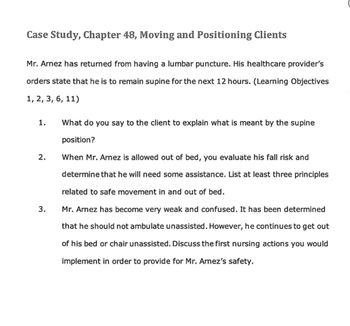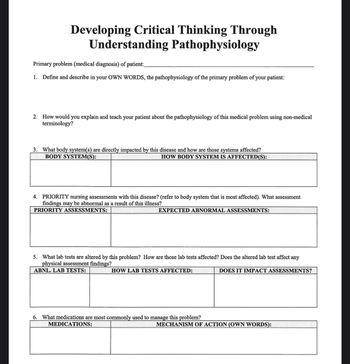
Phlebotomy Essentials
6th Edition
ISBN: 9781451194524
Author: Ruth McCall, Cathee M. Tankersley MT(ASCP)
Publisher: JONES+BARTLETT PUBLISHERS, INC.
expand_more
expand_more
format_list_bulleted
Question

Transcribed Image Text:### Case Study, Chapter 48, Moving and Positioning Clients
#### Scenario:
Mr. Arnez has returned from having a lumbar puncture. His healthcare provider’s orders state that he is to remain supine for the next 12 hours. (Learning Objectives 1, 2, 3, 6, 11)
#### Discussion Questions:
1. **What do you say to the client to explain what is meant by the supine position?**
To explain the supine position to Mr. Arnez, you could say: "The supine position means that you need to lie flat on your back. It's important for you to stay in this position for the next 12 hours to help reduce the risk of complications after your lumbar puncture."
2. **When Mr. Arnez is allowed out of bed, you evaluate his fall risk and determine that he will need some assistance. List at least three principles related to safe movement in and out of bed.**
- **Proper Body Mechanics:** Ensure that you use proper body mechanics when assisting Mr. Arnez. Bend at your knees, not your back, and avoid twisting your spine.
- **Use of Assistive Devices:** Utilize assistive devices such as a gait belt or a walker to provide additional support and stability.
- **Close Supervision:** Always stay close to Mr. Arnez when he is moving in or out of bed to catch him or provide immediate support if he begins to fall.
3. **Mr. Arnez has become very weak and confused. It has been determined that he should not ambulate unassisted. However, he continues to get out of his bed or chair unassisted. Discuss the first nursing actions you would implement in order to provide for Mr. Arnez’s safety.**
- **Implement a Bed Alarm:** Place a bed alarm under Mr. Arnez’s mattress, which will alert staff when he attempts to get out of bed.
- **Frequent Monitoring:** Increase the frequency of checks on Mr. Arnez to ensure his safety and provide assistance as soon as he needs to move.
- **Clear Communication:** Explain to Mr. Arnez the importance of asking for help before attempting to get out of bed or his chair. Make sure that the instruction is repeated periodically given his confusion.
- **Environment Safety:** Ensure that the environment around Mr. Arnez is free of clutter and falls hazards. Keep necessary items

Transcribed Image Text:---
## Developing Critical Thinking Through Understanding Pathophysiology
### Primary problem (medical diagnosis) of patient: ____________________________________
#### 1. Define and describe in your OWN WORDS the pathophysiology of the primary problem of your patient:
____________________________________________________________________________________
____________________________________________________________________________________
#### 2. How would you explain and teach your patient about the pathophysiology of this medical problem using non-medical terminology?
____________________________________________________________________________________
____________________________________________________________________________________
#### 3. What body system(s) are directly impacted by this disease and how are those systems affected?
| BODY SYSTEM(S) | HOW BODY SYSTEM IS AFFECTED(S) |
|---------------------|----------------------------------|
| | |
| | |
#### 4. PRIORITY nursing assessments with this disease? (Refer to body system that is most affected). What assessment findings may be abnormal as a result of this illness?
| PRIORITY ASSESSMENTS | EXPECTED ABNORMAL ASSESSMENTS |
|-------------------------|---------------------------------|
| | |
| | |
#### 5. What lab tests are altered by this problem? How are those lab tests affected? Does the altered lab test affect any physical assessment findings?
| ABNL. LAB TESTS | HOW LAB TESTS AFFECTED | DOES IT IMPACT ASSESSMENTS? |
|---------------------|----------------------------------|-------------------------------|
| | | |
| | | |
#### 6. What medications are most commonly used to manage this problem?
| MEDICATIONS | MECHANISM OF ACTION (OWN WORDS) |
|--------------------|----------------------------------|
| | |
| | |
---
This structured format can be used for educational purposes to help individuals develop critical thinking through understanding pathophysiology. Labels and columns help classify information efficiently and encourage comprehensive analysis and explanation of medical conditions.
Expert Solution
This question has been solved!
Explore an expertly crafted, step-by-step solution for a thorough understanding of key concepts.
This is a popular solution
Trending nowThis is a popular solution!
Step by stepSolved in 5 steps

Knowledge Booster
Similar questions
- Describe a difficult situation you had to deal with a patient at the front desk. How did you specifically handle the situation?arrow_forwardwhile helping a patient with a chest tube reposition in the bed, the chest tube becomes dislodged. what is your immediate nursing intervention?arrow_forwardFor a patient experiencing dyspnea, which nursing action is appropriate? A) Restrict fluids to reduce the workload on the heart B) Place the patient in a supine position to facilitate comfort C) Administer oxygen therapy as prescribed D) Encourage deep breathing exercises only during the dayarrow_forward
- 1.) Craig Samuels has become a frequent repeat visitor to the clinic in which Erin is a medical assistant. Craig complains of various pains and always asks for a prescription for pain medication. A.) What might be Craig's real reason for visiting the clinic? b.) What should Erin do? c.) How does the government control medications such as those that are prescribed for pain? d.) What is the medical assisting credential (the letters used after their name) offered by the American Association of Medical Assistants to those who pass their national certification exam?arrow_forwardWhat are the liability hazards of requiring all members of the medical staff to take Emergency Department duty?arrow_forwardI am to write in a COMPLETE Sentence a description of the “faux wound” that is located at the surface of the body at the TIP OF THE SWORD. In my sentence I need to include: Left vs right side of the body Regional terms (e.g., brachial, femoral, pectoral, antebrachial, axillary, among many others…see your PPTX for a list) Orientation terms (e.g., anterior, poster, lateral, medial, proximal, distal, superior, inferior). Bone, suture, muscle landmarks that will help you pinpoint the location. DISTANCES (you can use inches or cm) as needed to increase specificity.arrow_forward
- Why is it important that the patient completely relax the arm when the nurse is initiating an IV?arrow_forwardThe nurse is participating in a health promotion fair. When discussing aerobic exercise, the nurse should include which of the following points? Question 94 options: a) If one can't talk when exercising, the the appropriate level of energy is being used b) Each exercise session should last for at least 45 minutes, and preferably 60 c) Exercise should be done a minimum of 6 days a week d) Fast walking is a good form of aerobic exercisearrow_forwardClient number 1: 50-year old male who had a heart attack and stent placed with normal vital signs Client number 2: 46-year-old female with full-thickness burns to the leg who needs to have dressings changed Client number 3: 33-year-old male firefighter who has fallen and broken his right femur after surgery with pain in his leg Client number 4: 18-year-old male with wheezing and labored respirations unrelieved by an inhaler Client number 5: 74-year-old female with new onset dementia awaiting lab results Client number 6: 52-year-old female who has been recently diagnoses with diabetes type 2 and is getting discharged List the clients and care from the highest to lowest priorityarrow_forward
- A 65-year-old male is recovering from subtotal colectomy. You inform him that it is time to get out of bed to the chair. What nursing interventions should you perform prior to moving the patient from the bed to chair?arrow_forwardMrs. Smith is now hospitalized, having become ill during the flu season. She was initially diagnosed with severe bronchitis, but that diagnosis has been changed to pneumonia with respiratory failure. She remains cognitively intact and is able to communicate with her children, though only with short conversations. They are deciding if this is the time to ask for a do-not-resuscitate order should Mrs. Smith continue on a downhill trajectory and require intubation and life-support. Both children have been named in her DPAHC, with the eldest daughter as the primary contact and her brother as the individual to give consent should his sister decide she cannot fulfill this role. You are the nurse who has primarily been caring for Mrs. Smith and have spent the most time talking with her, understanding her fears, and knowing her strong desire to live and see her grandchildren as they grow to adulthood. How do you assist the family in coming to terms with this new setback and the real…arrow_forwardMrs. Thomas was on vacation out of state when she stepped off a curve and injured her left ankle. Due to severe pain she was seen at an urgent care center where she underwent a left ankle x-ray, which was negative. She was diagnosed with a left sprained ankle. A walking boot was provided to stabilize and protect her left ankle. She was provided with appropriate discharge instructions and instructed to follow up with her primary care physician upon returning home. When she presented her BlueCross BlueShield insurance card at check out, Mrs. Thomas was informed that the physician who provided treatment is a nonparticipating provider (nonPAR) and that the urgent care center accepts credit cards for payment in full. The total due was $1,500, and Mrs. Thomas assured the office staff that her insurance company would reimburse the urgent care center for services provided. The office staff further explained that their providers had not signed a contract with her insurance, and thus Mrs. Thomas…arrow_forward
arrow_back_ios
SEE MORE QUESTIONS
arrow_forward_ios
Recommended textbooks for you
 Phlebotomy EssentialsNursingISBN:9781451194524Author:Ruth McCall, Cathee M. Tankersley MT(ASCP)Publisher:JONES+BARTLETT PUBLISHERS, INC.
Phlebotomy EssentialsNursingISBN:9781451194524Author:Ruth McCall, Cathee M. Tankersley MT(ASCP)Publisher:JONES+BARTLETT PUBLISHERS, INC. Gould's Pathophysiology for the Health Profession...NursingISBN:9780323414425Author:Robert J Hubert BSPublisher:Saunders
Gould's Pathophysiology for the Health Profession...NursingISBN:9780323414425Author:Robert J Hubert BSPublisher:Saunders Fundamentals Of NursingNursingISBN:9781496362179Author:Taylor, Carol (carol R.), LYNN, Pamela (pamela Barbara), Bartlett, Jennifer L.Publisher:Wolters Kluwer,
Fundamentals Of NursingNursingISBN:9781496362179Author:Taylor, Carol (carol R.), LYNN, Pamela (pamela Barbara), Bartlett, Jennifer L.Publisher:Wolters Kluwer, Fundamentals of Nursing, 9eNursingISBN:9780323327404Author:Patricia A. Potter RN MSN PhD FAAN, Anne Griffin Perry RN EdD FAAN, Patricia Stockert RN BSN MS PhD, Amy Hall RN BSN MS PhD CNEPublisher:Elsevier Science
Fundamentals of Nursing, 9eNursingISBN:9780323327404Author:Patricia A. Potter RN MSN PhD FAAN, Anne Griffin Perry RN EdD FAAN, Patricia Stockert RN BSN MS PhD, Amy Hall RN BSN MS PhD CNEPublisher:Elsevier Science Study Guide for Gould's Pathophysiology for the H...NursingISBN:9780323414142Author:Hubert BS, Robert J; VanMeter PhD, Karin C.Publisher:Saunders
Study Guide for Gould's Pathophysiology for the H...NursingISBN:9780323414142Author:Hubert BS, Robert J; VanMeter PhD, Karin C.Publisher:Saunders Issues and Ethics in the Helping Professions (Min...NursingISBN:9781337406291Author:Gerald Corey, Marianne Schneider Corey, Cindy CoreyPublisher:Cengage Learning
Issues and Ethics in the Helping Professions (Min...NursingISBN:9781337406291Author:Gerald Corey, Marianne Schneider Corey, Cindy CoreyPublisher:Cengage Learning

Phlebotomy Essentials
Nursing
ISBN:9781451194524
Author:Ruth McCall, Cathee M. Tankersley MT(ASCP)
Publisher:JONES+BARTLETT PUBLISHERS, INC.

Gould's Pathophysiology for the Health Profession...
Nursing
ISBN:9780323414425
Author:Robert J Hubert BS
Publisher:Saunders

Fundamentals Of Nursing
Nursing
ISBN:9781496362179
Author:Taylor, Carol (carol R.), LYNN, Pamela (pamela Barbara), Bartlett, Jennifer L.
Publisher:Wolters Kluwer,

Fundamentals of Nursing, 9e
Nursing
ISBN:9780323327404
Author:Patricia A. Potter RN MSN PhD FAAN, Anne Griffin Perry RN EdD FAAN, Patricia Stockert RN BSN MS PhD, Amy Hall RN BSN MS PhD CNE
Publisher:Elsevier Science

Study Guide for Gould's Pathophysiology for the H...
Nursing
ISBN:9780323414142
Author:Hubert BS, Robert J; VanMeter PhD, Karin C.
Publisher:Saunders

Issues and Ethics in the Helping Professions (Min...
Nursing
ISBN:9781337406291
Author:Gerald Corey, Marianne Schneider Corey, Cindy Corey
Publisher:Cengage Learning